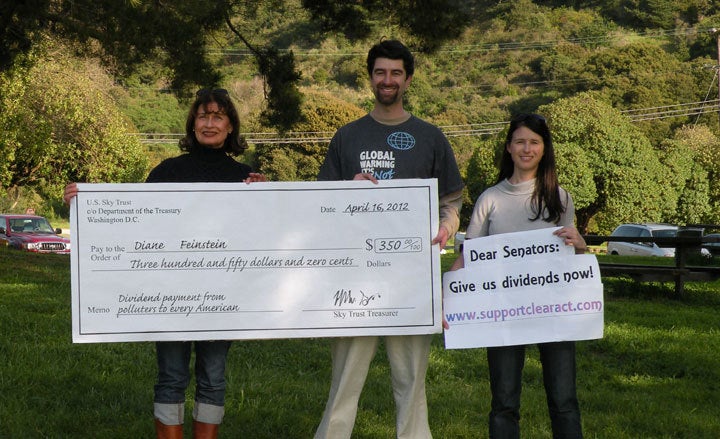
Climate dividend advocates in Point Richmond, California, March 2010. (The author at center)
Climate dividends are about to get serious consideration in California.
California’s Cap & Trade system to reduce greenhouse gas emissions could potentially expire in 2020, and must be extended by the State Legislature. A new Senate Bill (SB775) proposed by Senator Bob Wieckowski (D-Fremont) and Senator Kevin de León (D-Los Angeles), the President pro Tempore of the California State Senate (and a statewide leader on climate and environmental justice issues), could return 90% of auction revenues to households with climate dividends. Advocates for climate dividends have been waiting for something like this for ten years!
A future post will cover the details of the bill as more information comes out, but in the meantime, SB775’s release is a good excuse to review some highlights from the past 10 years of encouraging the State to give out climate dividends.
By the mid-2000s, Peter Barnes’ book Who Owns the Sky? had already laid the ground work for climate dividends, and California’s Global Warming Act of 2006 (AB32) offered a prime chance to implement the idea. The Carbon Share project was launched in early 2007, leading to several road trips to Sacramento, dozens of public comments at the Air Resources Board meetings, and this blog on Huffington Post. The ARB consulted various experts (including Dallas Burtraw, Dan Kammen, and James K. Boyce, who deserve special mention), reports were written, but no action was taken on dividends.
In 2010, Congress considered two cap & trade bills at the national level. The Waxman-Markey bill that passed the House would have given away permits for free to large industry and allowed unregulated offsets. Another bill, called the CLEAR Act, was a Cap & Dividend bill that would have made polluters pay and returned the money to consumers. The CLEAR Act did not advance, but became a platform for successive bills that were introduced in following years and kept the national dialogue around dividends going. Citizens Climate Lobby and scientist James Hansen also promoted climate dividends at the national level.
With Federal Cap & Trade stalled, California proceeded with designing its own Cap & Trade system . The California Air Resources Board convened the Economic and Allocations Advisory Committee (EAAC).
“The expert panelists said it was vital to sell permits to companies rather than give them away, and return 75 percent of revenues collected back to households, using the remaining 25 percent on renewable energy and related investments...[A] climate dividend will reduce economic uncertainty for working families...But all of this talk of offsets needlessly complicates the basics of a carbon permit system [where] polluters [simply] pay, and people get the money...If more people knew about this, instead of the lobbyists clamoring for offsets for nothing and permits for free, we might hear citizens demanding, ‘I want my, I want my, I want my dividend.’” ~Excerpted from “Greed Puts Climate in Dire Straits: Offsets for Nothin’ and Permits for Free”
The State’s initial design for Cap & Trade included some positive aspects like the auction with the escalating price floor, but the plan for how to use the auction proceeds was not transparent and when hundreds of millions were earmarked for high-speed rail and transit-oriented development, it took on an appearance of a slush fund for “pet projects.”
“For California to meet its AB32 goals, the state will need to do more than just tinkering with its energy and transportation systems...Opponents could easily tar cap and trade as another funding source for pet projects and boondoggles...” ~Excerpted from “Is Cap and Trade for Pet Projects or for Transformation?”
Environmental groups faced down a ballot initiative funded by the oil industry that attempted to derail the Cap & Trade system, as the State developed plans to spend auction revenues on projects such as high-speed rail.
“[Why is It falsely] presumed that the state legislature would be unable to pass any bill that allocates revenues with a two-thirds vote, even one that gives money to three-thirds of Californians...The moral basis for distributing proceeds of a sale of pollution rights to the Commons must be grounded in justice and equity, and the simplest formula to accomplish this is a per capita dividend...The state can still seize this prime opportunity to create a revenue-neutral program that reimburses the public for their share of revenues from the Commons.” ~Excerpted from “Climate Dividends: California’s Chance to Change Hearts and Minds”
By early 2013 it was not looking good for dividends, but then the California Public Utilities Commission issued a ruling creating the California Climate Credit, a $40 rebate appearing on household utility bills twice a year. Dividends became part of the Cap & Trade design conversation again.
”According to the recent book “With Liberty and Dividends for All“ by Peter Barnes, it should be up to the individuals receiving their share of the atmospheric commons to decide how to spend their windfall...Some would argue that market transformation requires that costly new technology must target elites first (that is Tesla’s business plan), but it gives ammunition to critics who already see the carbon price as regressive, and it accentuates the urban-rural/red-blue county divide as farm workers and rural residents watch cap and trade funds go towards affordable housing in cities and high speed rail...California should build upon the foundation of the California Climate Credit and return more funds back to people: one person, one share.” ~Excerpted from “Expanding on the California Climate Credit”
By late 2016, Legislators debated how equitably using the auction revenues and directing funds towards “disadvantaged communities” could be incorporated into designs for a post-2020 Cap & Trade program.
“Post-2020 the State could expand the [California Climate Credit] to an off-bill per capita dividend that would be simple, transparent, and be inclusive of disadvantaged communities not just coastal cities...California has shown leadership on climate change by creating a price on carbon. It can improve the program in its next phase, and perhaps gain supporters for the program’s extension, by decreasing subsidies to the fossil fuel industry, and depoliticizing the way funds are used by moving the funding for environmental programs into the regular budget process and returning Cap & Trade revenues back to people as climate dividends.” ~Excerpted from “For California's Post-2020 Cap And Trade, Give Money To People”
The announcement of SB775’s focus on using 90% of auction revenues as dividends to households is a huge boost to climate dividend advocates. If signed into law, it could make dividends the new model for the future of carbon pricing. SB775 could be the right bill at the right time, with 2017’s populist mood at the national level, ongoing economic inequality, and California’s desire for climate leadership. And if ten years of advocacy results in a successful program that transforms the economy in a greener direction, helps meet California’s climate goals, and returns hundreds of millions of dollars back to households, you will hear no complaints from me (for once).
